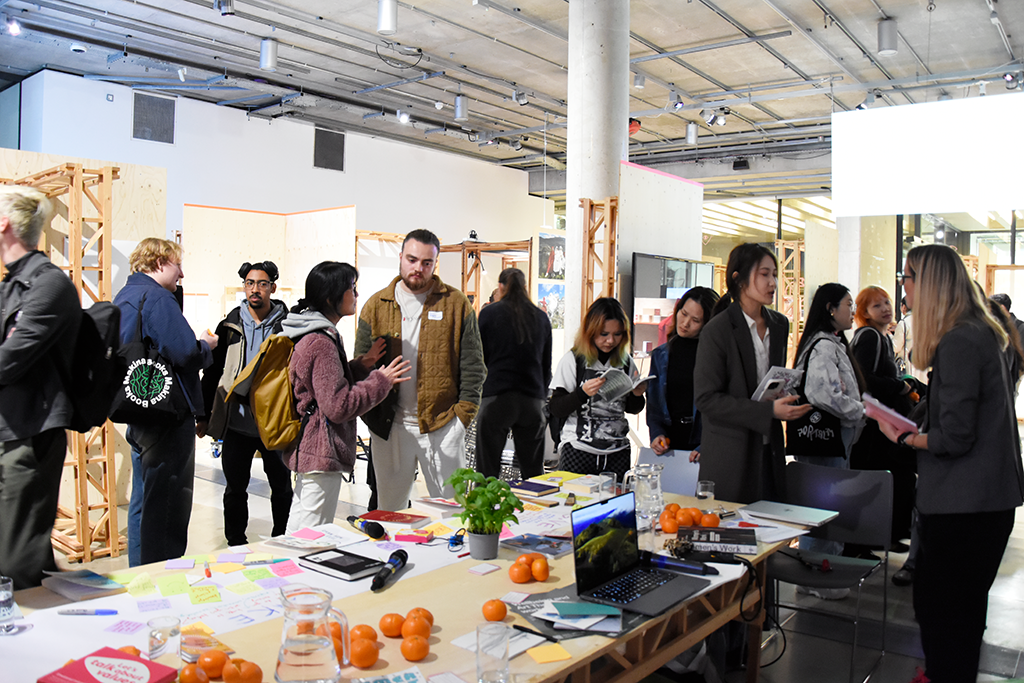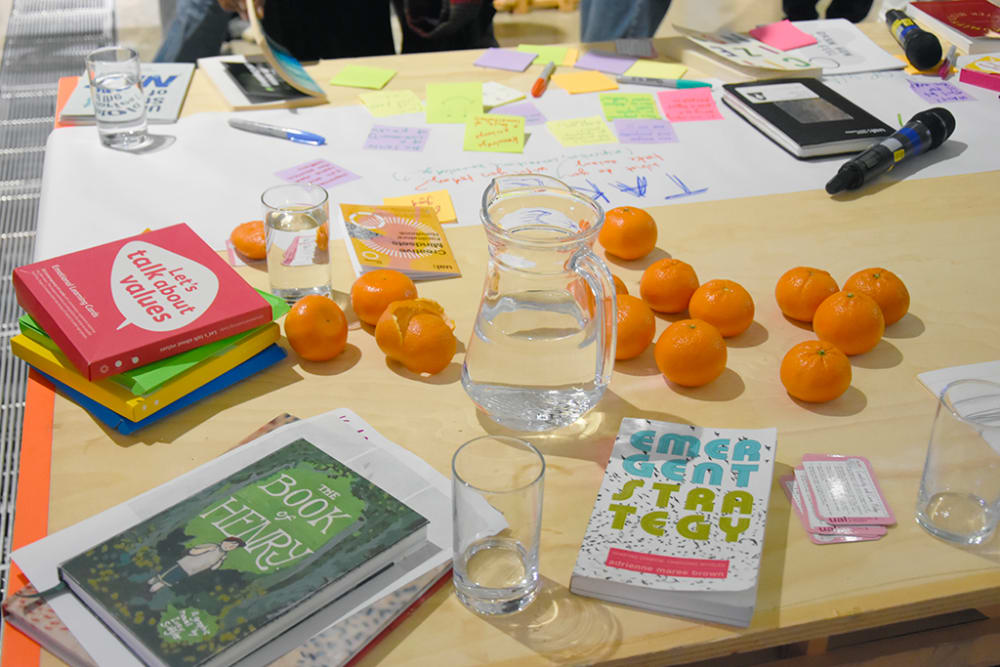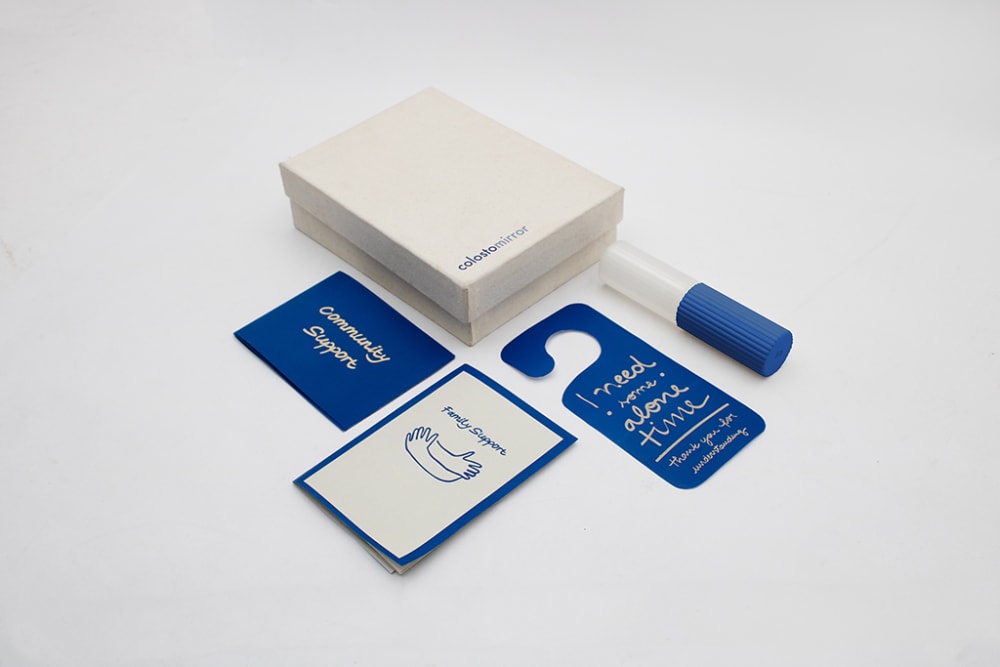
Artists, design graduates and curators join Hospital Rooms to discuss designing for wellbeing

- Written byUAL Showcase
- Published date 22 October 2024

‘Inspired’, ‘energised’ and ‘hopeful’ were some of the words used to describe our event with Niamh White, co-founder of Hospital Rooms, who was joined by a panel of creative practitioners to share how art and design interventions can support health and wellbeing.
Scheduled on the eve of World Mental Health Day, the event also launched Hospital Rooms’ recent Showcase collection Embodied Knowing, which features 14 graduate projects that address wellbeing through the visual arts, poetry, fashion, music and sculpture.

Programmed and chaired by Kate Keara Pelen, co-curator of The Observatory exhibition at Central Saint Martins, the session was designed to bring together lived experience, creative practice and clinical expertise in an ‘open fishbowl’-style discussion. Contributors included:
- Beatriz Ceni Lopes – Her project Colostomirror, on display in The Observatory until 31 October, is informed by Beatriz’s family history of bowel cancer and designed in collaboration with clinicians in the UK and Brazil to enhance care autonomy and social support post-surgery.
- Lucinda Siegler – The Book of Henry is a graphic novel about a semi-fictionalised account of Lucinda’s brother’s experiences at a therapeutic boarding school and the impact this had on him.
- Stella Sookun – A creative therapist and member of the UAL Student Counselling and Mental Health team, Stella reflected on the value of creative approaches in her therapeutic practice, particularly when working with younger people and neurodiversity, and how art offers different pathways to self-knowledge.
- Samuel Sant – Questioning the limits of Western medical orthodoxies, Sam’s Showcase project Mood Swing references wisdom traditions and ancient ritual practices in a series of kinetic incense burners designed to generate calm, pause and presence.
- Annie Frost Nicholson – UAL lecturer and artist Annie spoke about her work “Juicy Booth”, a sensory pod designed to facilitate the release of shame and guilt, open to the public in Coal Drops Yard until December 2024.
- Rachel Segal Hamilton – A writer, editor and lead for Showcase curated collections, Rachel reflected with Niamh on putting together her Showcase collection Embodied Knowing.

Besides speaking about their projects and respective practices, the event was also an opportunity for the panellists and guests to share personal encounters with illness and wellness, while reflecting on how creativity supported them through the processes of caring, healing and maintaining health.
“I was deeply moved and went home with a lot to reflect on, especially since my brother suffers from a serious neurological condition," said Jasmine Bhavik Shah, a student on the MA Global Collaborative Design Practice programme.
"I was left wondering— as a creative, why have I never looked inward to use this creativity to help me and my family cope with the challenges? Let's just say that this has opened up a big conversation in our family group!"
We caught up with some of the panellists to reflect on the event and the importance of creativity in supporting our wellbeing:

What stuck with you most after the event?
Samuel: I was particularly fascinated by the variety of ways in which the rest of the panel had wielded their creativity as a tool to make a real difference. However it was the passion for improving the lives of others, from both the panel and the audience, that has remained with me.
Stella: The willingness of our students to try and advocate for others to have a healthier and kinder experience than they have – via their creativity.
Annie: I think an atmosphere of safety was quickly created in the space, where stories could be shared and held – I was really moved by this and thought about what was shared for a long time afterwards.
Beatriz: What stuck with me most was how healing and empowering it is to share stories of struggle, and how inspiring it is to listen to how people acted on them, through connecting with others, therapy, art, or design.
Why do you think it’s important for creative practitioners from a variety of disciplines to come together with the public to discuss creative interventions and ideas for mental health and wellbeing?
Annie: I think this is always important and always will be/ should be, since tending to our collective mental wellbeing is essential both as human beings co-existing in the world and for the future of our practice. Particularly now, witnessing some of the worst of times in global politics, we need to reinforce that we do not and cannot exist in a vacuum and by sharing mechanisms for coping, for living with – and alongside – adversity, we are able to share common ground, to listen and to learn and to hopefully move forward in more informed ways.
Stella: It normalises difference and everyday challenges amongst the student and professional community – and this can be challenged creatively.
Beatriz: It is important because it may show the value of those interventions by educating people about creative practices, that sometimes feel distant and abstract to the public.
Samuel: It allows for a broader perspective on issues of mental health and wellbeing, which is not only informed by - and responding to - one set of experiences.
What does 'creative health' mean for you?
Stella: Staying connected to myself and others, creatively.
Annie: It means thinking of creativity as a long game, an ever-evolving practice, one which you take with you, or takes you with it, through life. Life mirroring art and art mirroring life. The best tool I've ever found to move through life with: a sanctuary, a lifeline.
Samuel: Creativity as a tool for improving the wellbeing of all.
Beatriz: Creative health for me is our inherent aspiration to live a better life and to proportionate that for the ones we love, we as creative beings constantly try to find new ways to achieve it.

